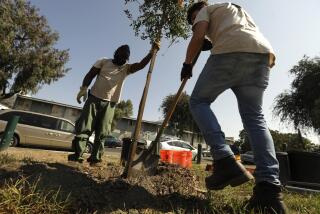Disparity seen in children’s obesity rates
- Share via
Obesity rates for children in low-income communities with few parks are up to nine times higher than for children in affluent areas with abundant recreational access, according to a new report that analyzes childhood obesity in the cities and communities of Los Angeles County.
The rates ranged from a low of 4% in Manhattan Beach, which has a median income of $100,750 and 5.7 acres of green space per 1,000 people, to 37% in Maywood, where the median income is $30,480 and 0.6 of an acre per 1,000 people is devoted to recreation.
Other studies have linked obesity to income and park access, but the degree of disparity in Los Angeles County “is always surprising and always very disturbing,” said Dr. Jonathan E. Fielding, director of the county Department of Public Health, which released the report Friday.
Countywide, almost 23% of public school students in the fifth, seventh and ninth grades were obese in 2005, the report found.
Obesity is associated with diabetes, heart disease, asthma and bone and joint problems.
“This is the biggest epidemic we have in Los Angeles County,” Fielding said.
The Institute of Medicine recently called childhood obesity one of the 21st century’s most critical public health threats and said that it could undo gains made in life expectancy during the previous century. Rates for adults and children have been rising nationwide since the mid-1970s.
“The statistics just highlight the work we still need to do,” said Los Angeles City Councilwoman Jan Perry. “They affirm that we’re on the right track fighting for more green space, more recreational activities, working with LAUSD to help children make better food choices.”
Perry has proposed a moratorium on fast-food restaurants in South L.A. that is making its way through council committees. Her council district, which includes parts of South L.A., has an obesity rate of 29% and 0.4 of an acre of parkland per 1,000 people.
The county report, which can be accessed at lapublichealth.org/epi/, used U.S. census data to rank communities according to an “economic hardship index” and used the 2006 Thomas Bros. digital mapping database to quantify open and recreational spaces.
Data on obesity came from the annual California Physical Fitness Testing program.
Children are considered obese if their body mass index -- calculated based on height and weight -- exceeds the 95th percentile for their age and gender.
--
More to Read
Sign up for Essential California
The most important California stories and recommendations in your inbox every morning.
You may occasionally receive promotional content from the Los Angeles Times.













